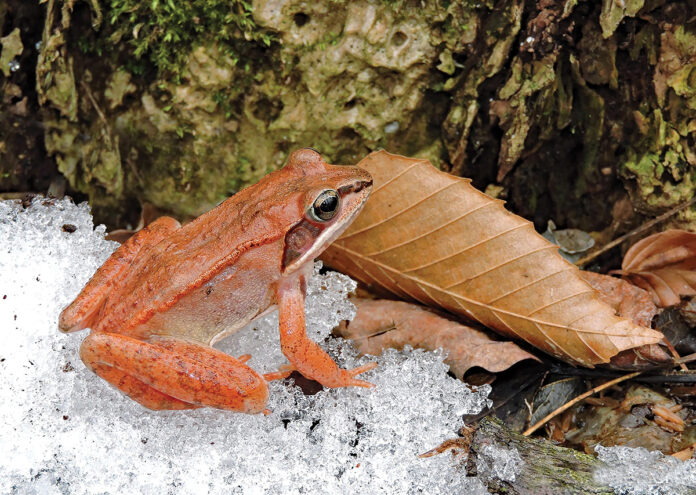
Every four years we celebrate Leap Year and 2024 is no exception. A leap year is a year that has an extra day added to the calendar — Feb. 29.
We follow the Gregorian calendar, a system that was introduced in 1582 and consists of an ordinary year made up of 365 days, divided into 12 months with an additional day added every fourth year. You see, when the Earth orbits around our Sun, it actually takes approximately 365.25 days. As this additional quarter day adds up, our calendar year becomes out of sync with our astronomical year. Adding an extra day every four years is how we are able to realign our calendar with the seasons. People born on Feb. 29, also known as Leap Day, belong to an elite group known as “leaplings.”
Wood frogs
There are many animals that leap, hop, jump, spring or bound and many have been associated with leap year, but none as often as the frog. It just so happens that one of our native frog species is waking up and becoming active right now. The wood frog (Rana sylvatica) is a terrestrial frog found in woodlands. Its base colors range from dark brown to shades of gray, tan and pink with cream-colored bellies. A dark brown “mask” that extends from the nostrils, around and behind the eye is its most tell-tale marking and aids in camouflage. Adult female wood frogs can measure up to 3.25 inches while males are slightly smaller. As they traverse the forest floor, the frogs use their sticky tongues to catch a variety of insects, spiders, slugs, worms and other arthropods.
The wood frog is the only frog species whose range extends north of the Arctic Circle making it one of the most unique amphibians on the planet. As temperatures plummet, the frogs stop breathing. Their hearts stop beating. They freeze completely, rock-hard solid. Yet, because of an incredible adaptation, they remain alive and protected. As ice starts to form inside their bodies, they begin to produce a special antifreeze that protects the cells of their organs and tissues throughout the winter. Amazingly, as temperatures begin to warm, the frogs thaw, coming back to “life” and carrying on with their normal activities.
Explosive breeding

It is in late February through March, when temperatures begin to rise and spring rains fill woodland depressions known as vernal pools, that the wood frogs make their debut. In a behavior known as “explosive breeding,” both males and females await a day with perfect conditions to begin their annual migration across the forest floor, descending into their native pools at the same time. In an all-out frenzy, males begin to call. Unlike the stereotypical “ribit” associated with frogs, the wood frogs inflate air sacs on either side of their heads, enabling them to make a sound that resembles the quack of a duck. Many a person has been fooled while on a spring walk by what sounds like a flock of mallards quacking incessantly, deep within the forest.
Upon entering the pool, male wood frogs float upon the water surface, their legs splayed and trailing out behind them. Using them like paddles, they propel themselves through the water, making contact with other frogs in an effort to locate a female. To watch them reminds me of hundreds of bumper cars moving madly about.
It’s hard to believe that in all of this chaos, females are actually listening to the individual calls of the males and making an effort to select their mate. When the two frogs finally come together, the male climbs on top of the larger, lighter-colored female and gives her an incredibly strong bear hug, a position known as amplexis. Together they cruise the pool, searching for the perfect submerged branch on which to deposit their eggs.
Eventually, the female begins to anchor a quarter-sized packet containing between 500 to 3,000 eggs. As the eggs exit her body, the male fertilizes them in a process known as external fertilization. Upon contact with the water, a gelatinous substance swells around each egg creating a baseball-sized mass many times larger than the female who deposited it. This important jelly-like substance serves many purposes including protecting the eggs and keeping them from drying out should the water level in the pool become low between rain events.

With egg laying complete, the frogs exit the pool, returning to their woodland haunts for another year. Within a week, tiny tadpoles work their way through the glutinous covering and begin feeding on algae and other plant material. They grow incredibly fast, as they are in a race with time to complete their development before the vernal pool dries out for the summer months. At about 40 days of age, tiny froglets can be seen around the pool edges, venturing forth into the great unknown. In one or two years, they will return to this very same pool on which they are imprinted to perpetuate their species, and maybe, just maybe, one of these explosive breeding events will appropriately occur on Leap Day itself!
•••
To view a short video I shot of this amazing event in action, please visit https://youtu.be/rveNMCruekU or view below and don’t forget to turn up the volume!












